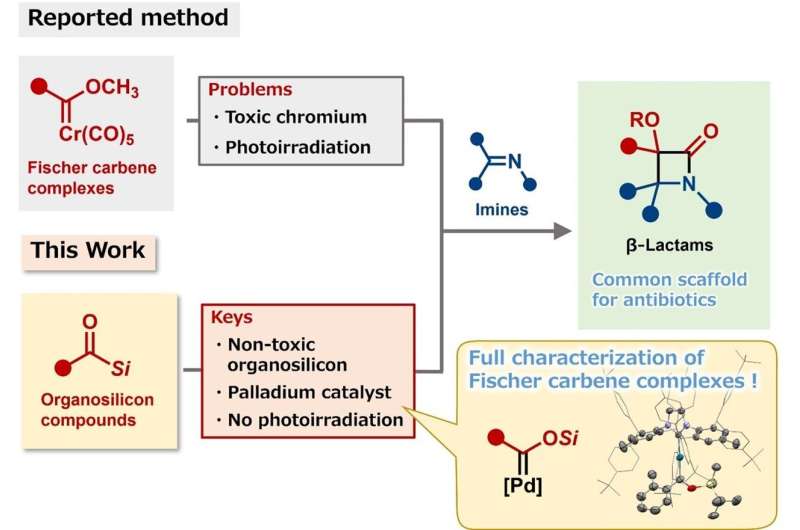This article has been reviewed according to Science X's editorial process and policies. Editors have highlighted the following attributes while ensuring the content's credibility:
fact-checked
peer-reviewed publication
trusted source
proofread
One-step synthesis of the most common, yet highly intricate, antibiotic molecular scaffold

While we appear to live in a world of plenty, behind the scenes, sourcing sufficient amounts of key ingredients can be challenging. For example, the synthesis of certain antibiotics, beta-lactam antibiotics, requires certain molecules in large quantities, and getting enough of these molecules has historically been difficult.
In a study, titled "Catalytic synthesis of β-lactam derivatives by carbonylative cycloaddition of acylsilanes with imines via a palladium Fischer-carbene intermediate" and published in Nature Catalysis, researchers from Osaka University unveil a new, simplified way to synthesize the intricate beta-lactam scaffold that is characteristic of beta-lactam antibiotics.
Penicillin, the first mass-produced antibiotic, is an example of a beta-lactam antibiotic. These antibiotics are the first choice for certain bacterial infections because they are more selective and less toxic than most drugs. Unsurprisingly, there are dozens of beta-lactam antibiotics approved for clinical use and under development.
Unfortunately, synthesizing these antibiotics in the laboratory has been challenging owing to their small but intricate structure. Thus, catalysts are typically needed to facilitate critical steps during synthesis. One catalyst, known as a Fischer-carbene complex, works well but needs to be used in large quantities. The synthesis of a Fischer-carbene catalyst that works in small quantities was the goal of the research team's study.
"Our new catalytic system can generate Fischer-carbene complexes from organosilicon compounds, which are non-toxic," explains Tetsuya Inagaki, lead author of the study. "What's more, we were able to isolate and characterize a key intermediate: a siloxycarbene–palladium complex."
Unlike previous Fischer-carbene synthetic protocols, the process does not result in toxic chromium waste and does not require photo-irradiation. The reaction proceeds in just one step, is operationally straightforward, and requires only a small quantity of catalyst. The researchers used it to prepare the scaffold of the thienamycin antibiotic in 94% yield.
"We're excited because our research will help synthesize Fischer-carbene catalysts that are otherwise difficult to isolate, and provide access to structurally complicated beta-lactam building blocks in one reaction vessel," says Mamoru Tobisu, senior author. "We look forward to applying our reaction protocol to other classes of synthetic targets."
This work is an important step forward in simplifying the synthesis of beta-lactams, the most common molecular scaffold of antibiotics. Because the synthetic protocol is simple and minimally toxic, applications to further chemical transformations should be straightforward.
More information: Tetsuya Inagaki et al, Catalytic synthesis of β-lactam derivatives by carbonylative cycloaddition of acylsilanes with imines via a palladium Fischer-carbene intermediate, Nature Catalysis (2024). DOI: 10.1038/s41929-023-01081-5
Journal information: Nature Catalysis
Provided by Osaka University




















